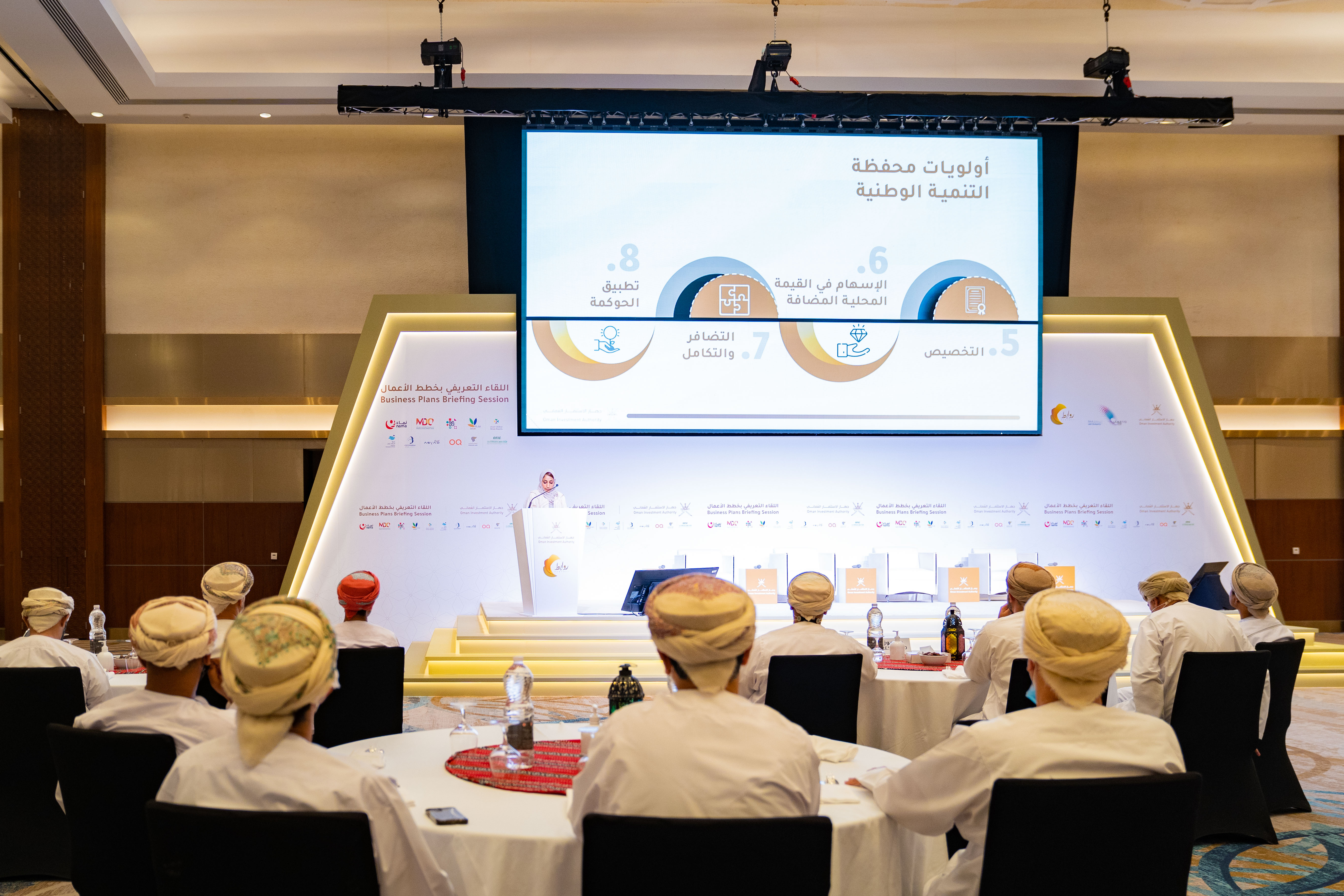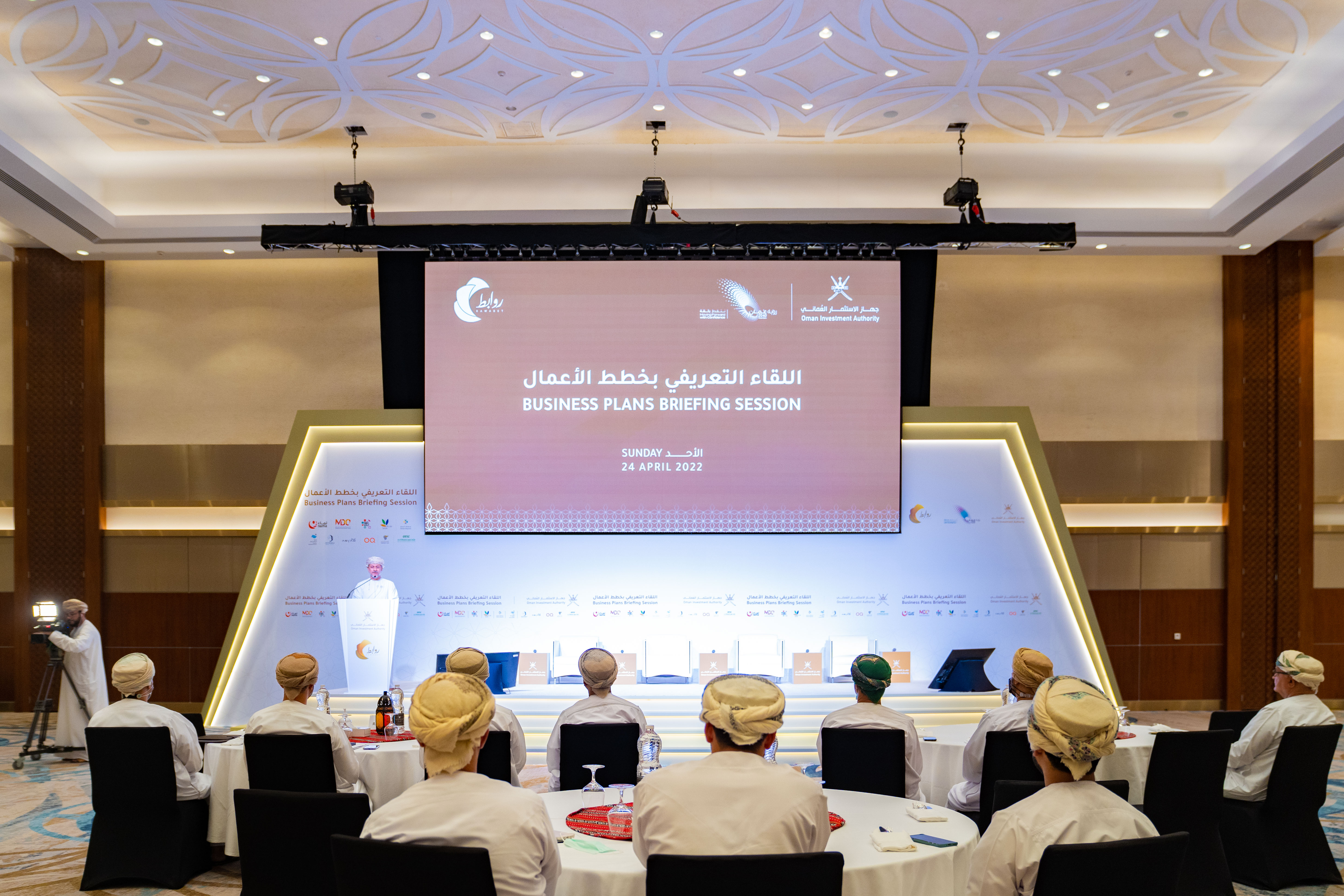2022-04-24
OIA and its companies showcase their performance over the last few years and disclose their upcoming projects
 To reaffirm its commitment to transparency, Oman Investment Authority (OIA) organized the ‘Business Plans Briefing Session.’ The event was attended by OIA officials, CEOs of OIA Companies and local banks, economists, media professionals, and entrepreneurs. It featured presentations by OIA and its companies, covering their performance over the last years and their projects in the upcoming years 2022-2026, and addressed the questions from the reporters representing various media outlets.
To reaffirm its commitment to transparency, Oman Investment Authority (OIA) organized the ‘Business Plans Briefing Session.’ The event was attended by OIA officials, CEOs of OIA Companies and local banks, economists, media professionals, and entrepreneurs. It featured presentations by OIA and its companies, covering their performance over the last years and their projects in the upcoming years 2022-2026, and addressed the questions from the reporters representing various media outlets.
In his opening remarks HE Abdulsalam Al-Murshidi, the President of Oman Investment Authority, said that “OIA has two main portfolios with clear objectives and mandates guaranteeing no overlap. These portfolios are ‘the National Development Portfolio,’’ which manages over 160 national assets and companies. This portfolio contributes to the national economic growth and development and supports the national GDP through dividends distributions, privatization returns, and treasury management. The other portfolio is ‘the Futures Generations Fund,’ which consists mainly of all international assets and some local assets; it covers public and private markets and real estate investments. All in aims to achieve maximum returns for future generations.”
Hisham Al-Sheedi, Director of Economic Diversification Investments at Oman Investment Authority commented on the event, saying that “the event’s agenda embodies OIA’s commitment to social engagement, and its efforts towards realizing the priorities of Oman Vision 2040, specifically in terms of economic diversification, empowering the private sector, attracting foreign investments, and financial sustainability. OIA Companies’ business plans are based on several principles, most prominently governorate development, creating job opportunities for job seekers and business opportunities for local Small and Medium Enterprises (SMEs), and achieving financial savings.”
 In its presentation, OIA discussed its two primary portfolios, which: the National Development Portfolio and the Future Generations’ Fund. This event revolved around the National Development Portfolio, which covers OIA’s national assets, including the companies presenting during the event. This portfolio targets contributing to the national economic growth and development besides supporting the national GDP.
In its presentation, OIA discussed its two primary portfolios, which: the National Development Portfolio and the Future Generations’ Fund. This event revolved around the National Development Portfolio, which covers OIA’s national assets, including the companies presenting during the event. This portfolio targets contributing to the national economic growth and development besides supporting the national GDP.
The National Development Portfolio saw many milestones, starting with the transfer of national assets to OIA in June 2020, moving to the restructuring of boards of directors, establishing Rawabet Program, initiatives like ‘Tarsheed’ and ‘Qimam,’ setting key performance indicators on boards of directors, and finally submitting initial drafts of business plans.
OIA’s presentation also highlighted eight priorities of the National Development Portfolio, starting with financial sustainability by enhancing the contribution of specific sectors like tourism, agriculture, fisheries, and ICT to the portfolio's profitability. Moreover, reducing the general debt of the portfolio by 32%. The second priority is selective growth in specific sectors, where capital expenditure is set to reach OMR 6.7 billion between 2022 and 2026, 30% of which will be spent on new growth initiatives.
The third priority focuses on contribution to the GDP, while the fourth seeks to attract private investors through new investments, divestments, and privatization. This priority is set to generate OMR 1 billion in 2022 from private investments. Furthermore, the fifth priority aims to privatize over 20 assets between 2022 and 2026 and achieve OMR 2.6 billion from these divestments.
Contribution to In-country Value (ICV) is the focus of the sixth priority, which was realized through launching the ICV initiative ‘Qimam.’ As for the seventh priority, it highlights the vital aspect of synergies between the portfolio’s assets in over 100 elements including supply-chain, digital transformation, human resources, and revenue. Finally comes the eighth priority, which is the implementation of governance and transparency through the Code of Governance for OIA Entities; more than ten policies and guidelines were issued, OIA is currently working on some new initiatives, including Environmental Social Governance (ESG), treasury, business plans, and disclosure of financial performance.
During this public briefing session, 11 OIA Companies presented, showcasing their performance over the last years, their business plans for the upcoming years, and their projects between 2022 and 2026. These companies were Fisheries Development Oman (FDO), Oman Food Investment Holding Company (OFIC), Asyad Group, ITHCA Group, OQ, Minerals Development Oman (MDO), Be’ah, Nama Group, Omran Group, Oman Air, and Oman Airports. These presentations transparently disclosed the performance of these companies utilizing various performance measurements. In addition, they introduced the attendees to the planned upcoming projects and strategies as per the companies’ strategic directions.
.jpg) Rawabet’s Strategic Pillar targets the alignment of OIA Companies’ business plans with OIA’s strategies and Oman Vision 2040. The objective is to achieve financial and operational sustainability, stimulate and enable sectors outlined in Oman Vision 2040, promote high efficiency in allocating capital resources to achieve economic diversification and growth, and encourage the private sector to partake in current and new investments. Subject matter experts in Rawabet were able to prepare eight strategic priorities, develop the Business Plans Guidelines, review over 20 companies’ policies, and establish key performance indicators for boards of directors for OIA companies. Companies are expected to submit the first draft of their business plans in August 2022 and the final draft in October 2022. OIA is set to approve these plans by November 2022.
Rawabet’s Strategic Pillar targets the alignment of OIA Companies’ business plans with OIA’s strategies and Oman Vision 2040. The objective is to achieve financial and operational sustainability, stimulate and enable sectors outlined in Oman Vision 2040, promote high efficiency in allocating capital resources to achieve economic diversification and growth, and encourage the private sector to partake in current and new investments. Subject matter experts in Rawabet were able to prepare eight strategic priorities, develop the Business Plans Guidelines, review over 20 companies’ policies, and establish key performance indicators for boards of directors for OIA companies. Companies are expected to submit the first draft of their business plans in August 2022 and the final draft in October 2022. OIA is set to approve these plans by November 2022.

